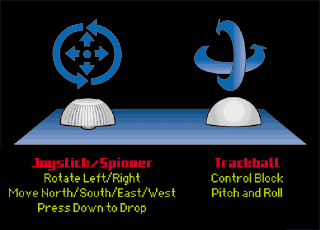 |
 |
 |
||||
 |
||||||
| Technos' 1989 Block Out | |
| Gameplay | |
|
|
This game is a lot of fun. "Duh! That's because it's called Tetris. Along with Space Invaders, Pac-Man and Doom, it's one of the most ripped-off games of all time. But I suppose you're gonna say this one's different because it's 3D...right?" Well...not anymore. True, Block Out is essentially 3D Tetris. Aside from the new perspective Block Out doesn't really add anything to the Tetris formula in terms of actual gameplay. Instead of maneuvering falling blocks into position in a 2D wall, Block Out challenges you to do the same thing while looking down into a 3D pit. The added dimension does offer added challenge but the object is the same as in Tetris -- maneuver your different shaped blocks into the empty spaces of each level. Entirely filling a level causes it to disappear and your stack of blocks will drop a level within the pit. But what Block Out may lack in originality it more than makes up for in presentation. Instead of dancing Russians, Block Out presents the player with a slick, hi-tech environment enhanced by 3D graphics, great music (although slightly reminiscent of 80's keyboard-heavy comedy soundtracks,) and a disembodied head that taunts you between levels (similar to the alien in Space Fury although with a smaller vocabulary.) |
| Missing Ingredient | |
Unfortunately Block Out is burdened by a somewhat cumbersome set of controls that do nothing to enhance the overall 3D theme of the game. Exploring the dipswitch options in MAME it appears that Block Out can be configured to be played with a joystick to control the position of the blocks and either two or three buttons controlling rotaion of the blocks. Getting used to which buttons control which rotation axis can be confusing and isn't very intuitive when dealing with 3 dimensions. The control issue is further clouded by the fact that a search on the web for Block Out cabinet pictures turns up variations that use a single joystick with buttons, and an apparent dual joystick version (with a total of 4 joysticks to accomodate two players simultaneously.) If Atari had developed this game during their heyday you could have been assured of one thing: The unique, 3D gameplay would have certainly been matched by an equally unique set of controls. Consider the precise trackball control of Marble Madness. The instant response of Tempest's spinner and the natural feel of flying through space with the Star Wars flight yoke. Take this layout for example:
A short, left-handed joystick topped off with a slightly spherical spinner control. Cupping the spinner in the palm of your left hand would give you access to the block'sleft/right rotation while at the same time allowing you to push the block in 4 directions with the joystick. Then a trackball, controlled with the right hand, would rotate the falling blocks in 3D space. While this type of layout would have added a certain cost and complexity to the game, perhaps it would have also added to the 3D feel of the game providing a more intuitive way to navigate within Block Out's 3D space.
| |
Thanks to Jeffrey Carl at ServInt for providing the space for CinemArcade
NEWS | ARCADE '84 | MOVIES | POSTERS | DESKTOPS | WHATEVER | CONTACT
All content © Dave Dries unless otherwise stated
